Intel Dual-Core Mobile Ivy Bridge Launch and i5-3427U Ultrabook Review
by Jarred Walton on May 31, 2012 12:01 AM EST- Posted in
- Laptops
- CPUs
- Intel
- Ivy Bridge
- Ultrabook
Ivy Bridge Ultrabook General Performance
We’ve taken most of the performance results from our AMD Trinity review and simply added the Ivy Bridge Ultrabook results to those graphs. (If you’re wondering, we’ve dropped most of the thicker laptops from the comparison, though we’ve kept quad-core IVB as a reference point.) This will give you a high level picture of what you can expect from Ivy Bridge ULV relative to quad-core Ivy Bridge, Trinity, Llano, and several other laptop configurations. We’ve also added results from Anand’s preview of the ASUS UX21A, which sports a 1080p IPS panel stuffed into an 11.6” form factor along with an i7 ULV processor, and we have the Dell XPS 13 and HP Folio 13 as representatives of Core i7 and Core i5 Sandy Bridge Ultrabooks, respectively.
As always, should you want to make additional comparisons, head over to Mobile Bench and have at it. Here are a few direct comparisons you might be interested in making: i5 IVB ULV vs. i5 SNB ULV, i5 IVB ULV vs. i7 SNB ULV, and i5 IVB ULV vs. A10-4600M. Our graphs will use abbreviated names for the laptops, just to keep things clean, but here is a quick specifications overview of the laptops we’re including in our charts. Please note that not all products are priced the same, though we’ve done our best to minimize differences in the test configurations on several laptops by installing the same Intel 520 240GB SSD used in the prototype IVB Ultrabook.
| Laptop Configuration Overview | ||||
| Laptop | CPU | Graphics | Storage | Battery |
| Acer TimelineU M3 | Intel i7-2637M | GT640M/HD3000 | 256GB SSD | 55Wh |
| AMD Llano Prototype | AMD A8-3500M | HD6620G | 240GB SSD | 58Wh |
| AMD Trinity Prototype | AMD A10-4600M | HD7660G | 128GB SSD | 56Wh |
| ASUS N56VM | Intel i7-3720QM | HD4000 | 240GB SSD | 56Wh |
| ASUS Zenbook Prime UX21A | Intel i7-3517U | HD4000 | 128GB SSD | 35Wh |
| Dell Vostro V131 | Intel i5-2410M | HD3000 | 240GB SSD | 65Wh |
| Dell XPS 13 | Intel i7-2637M | HD3000 | 256GB SSD | 47Wh |
| HP Folio 13 | Intel i5-2467M | HD3000 | 128GB SSD | 60Wh |
| Ivy Bridge Ultrabook Prototype | Intel i5-3427U | HD4000 | 240GB SSD | 47Wh |
We’re only going to highlight two laptops for this roundup: the Ivy Bridge Ultrabook and the ASUS Zenbook Prime UX21A. The latter is going to be similar in most respects, but it’s also a retail product. It has a smaller form factor, a slower SSD, a higher resolution LCD, and a faster Core i7 IVB ULV processor. The quad-core IVB ASUS N56VM is in a different category, obviously, as it uses more power and is significantly larger. AMD’s Trinity is also a bit of an odd comparison, as it’s a full voltage 35W part; hopefully we can get some 17W Trinity laptops in for testing to see how AMD’s Ultrabook alternative fares. In the meantime, keep these considerations in mind. We’ll start as always with PCMark performance.
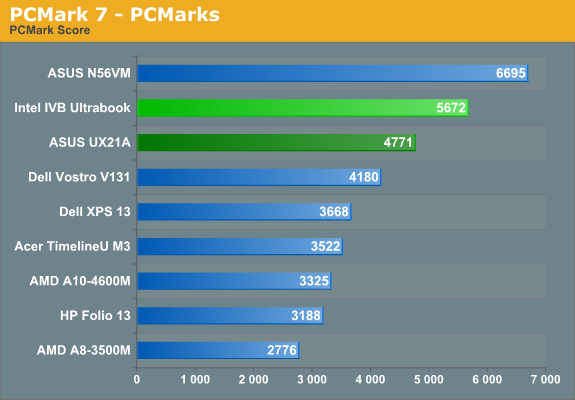
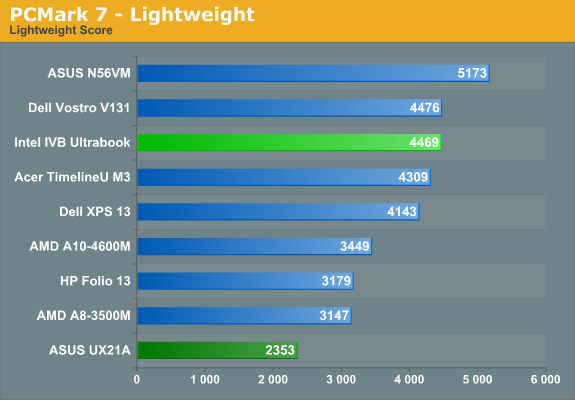
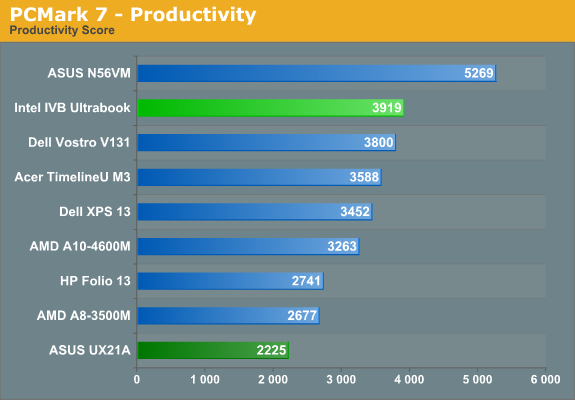
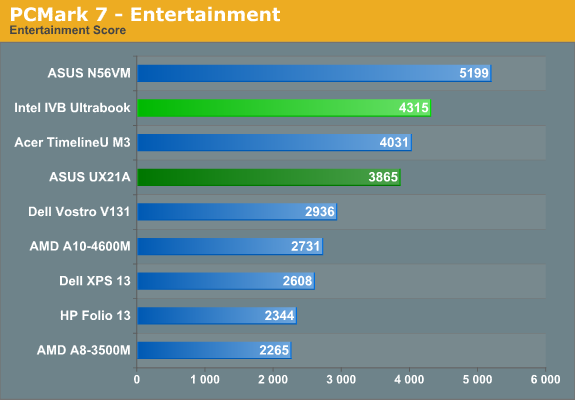
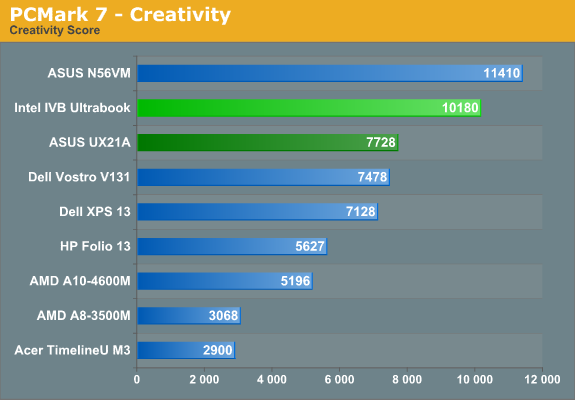

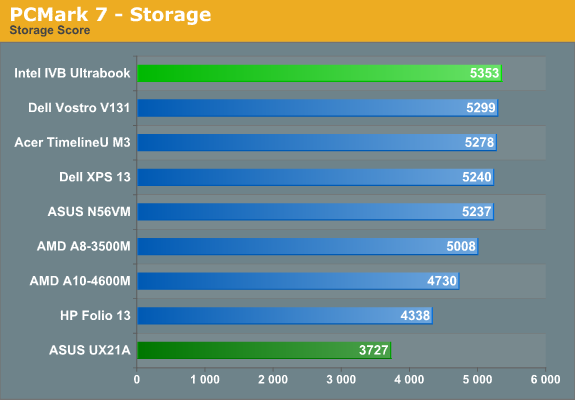
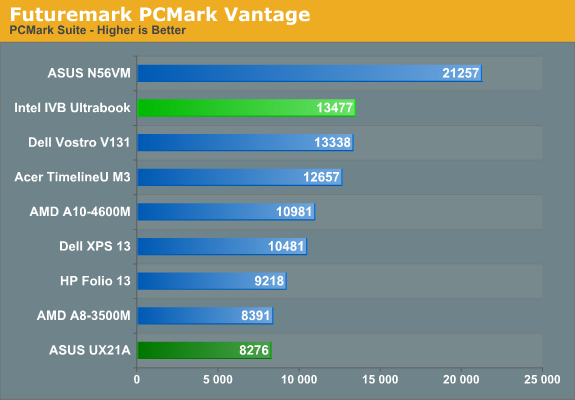
We’ve mentioned before how much PCMark scores tend to skew towards laptops with SSDs. The good news is that all of the laptops in our charts for this article have SSDs; the bad news is that there’s another element at play that can dramatically influence a couple of scores. That element is Intel’s Quick Sync technology, which is supported by PCMark 7 and has a major impact on the Creativity and Computation test suites, and a lesser impact on the Entertainment suite. We don’t know exactly how much the higher Computation/Creativity scores affect the overall score, but it’s definitely a factor. To that end, PCMark Vantage is a nice look at overall performance without any Quick Sync optimizations present.
Given what we just said about Quick Sync, it’s not too surprising that Ivy Bridge—even in ULV attire—dominates many of the PCMark 7 charts. The ASUS UX21A standings are severely hampered by the SanDisk U100 SSD, making direct comparisons with the PUB-RD Ultrabook impossible in PCMark. Look at our prototype scores however and we find that it offers performance that’s generally better than a last-generation standard voltage Sandy Bridge laptop (e.g. the Dell Vostro V131).
Without testing every single laptop with the same SSD (and arguably with and without Quick Sync enabled), PCMark scores only give us an abstract view of system performance. As we’ve noted in the past, every single laptop in our charts is going to be “fast enough” for typical home and business use. The real differentiator between laptops is going to be build quality, form factor, design elements, and what applications you plan on running (e.g. complex number crunching apps would benefit from more CPU performance, while games will benefit from faster graphics). To help flesh out our understanding of Ivy Bridge ULV performance and how it compares to other laptops, we’ve got CPU-centric and GPU-centric tests.
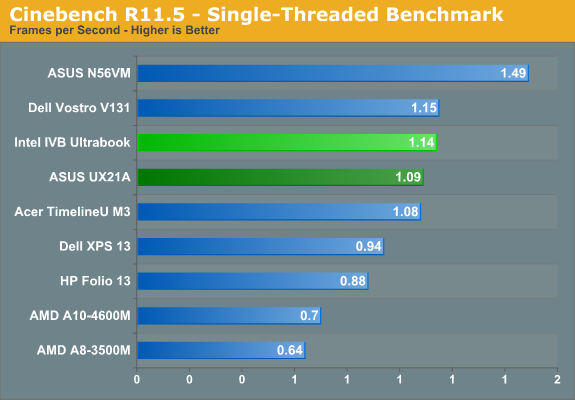
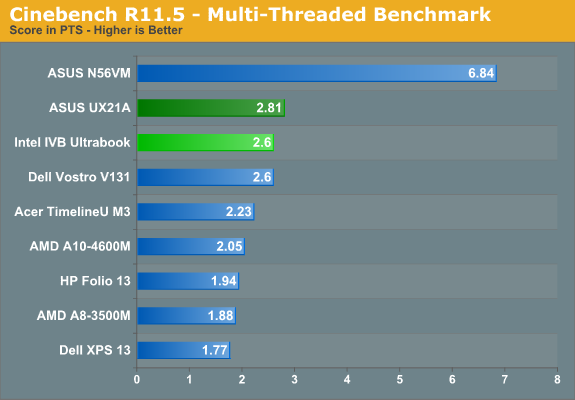
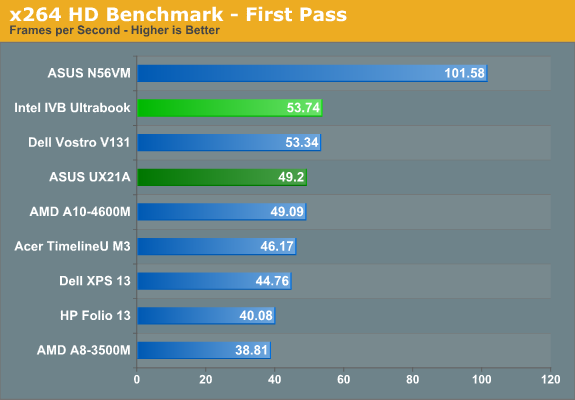
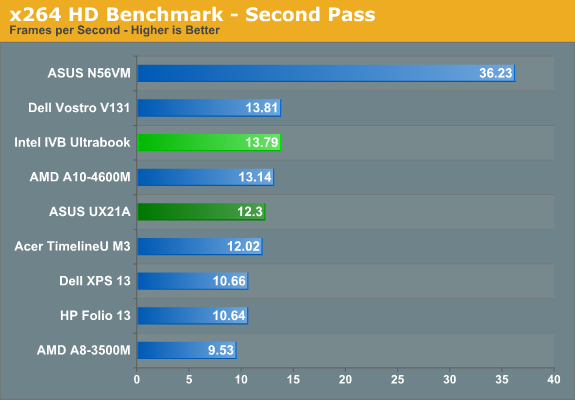
Cinebench is a great look at pure CPU performance, and the workload is such that L3 cache sizes frequently don’t come into play. Obviously quad-core IVB is in a different category, but of the dual-core parts that we’ve included, IVB ULV tops the charts. The ASUS UX21A with its slightly faster Core i7 processor leads in the multi-threaded test, but apparently thermal constraints keep it from hitting maximum Turbo in the single-threaded test and the larger Core i5 Ultrabook comes out ahead. We see a similar situation with the x264 benchmarks, with the Ivy Bridge prototype Ultrabook beating the in-theory-faster UX21A CPU by around 10%.
I have to admit I’m not a big fan of 11.6” laptops to begin with, probably because I’m 6’3” (190cm) and have trouble typing on the smaller keyboards, but thermals are another factor. I’ve stated before that personally, 13.3” or 14” laptops are my favorite size, and I don’t mind 15.6” laptops if they come with added performance and features. Given the comparison between the PUB-RD prototype and the UX21A, I’d rather have a slightly larger Ultrabook. The ASUS UX31A/UX32A on the other hand…it looks like those are going to be the Ultrabooks to beat this round.










64 Comments
View All Comments
mikk - Thursday, May 31, 2012 - link
Why you don't record the frequency used in games with gpu-z? This would be interesting. And it would be also interesting to see how it performs with a disabled cpu turbo to give more headroom for the iGPU.JarredWalton - Thursday, May 31, 2012 - link
GPU-Z doesn't detect HD 3000/4000 frequency; in fact, I'm not sure anyone has a utility that correctly reports HD 4000 core clocks. If I'm wrong, please let me know as I'd love to be able to do a FRAPS run and log the iGPU clocks! If you know of one, please post and/or email me.mikk - Thursday, May 31, 2012 - link
JarredWalton: "GPU-Z doesn't detect HD 3000/4000 frequency; in fact, I'm not sure anyone has a utility that correctly reports HD 4000 core clocks. If I'm wrong, please let me know as I'd love to be able to do a FRAPS run and log the iGPU clocks! If you know of one, please post and/or email me"You are wrong, gpu-z 0.6.2 fully supports the HD4000, you can "log to file" the frequency. I have tried it myself on a Desktop HD4000. It's interesting. Due to some driver issues some games did not run with the max turbo frequency ony my Desktop 77W model. It's fixed with driver build 2752. There are several turbo steps between base 350/650 and max turbo 1150 Mhz.
JarredWalton - Thursday, May 31, 2012 - link
Going to go check now... I think I might have been running an older version (6.0?) I'll update the article when I have some details. Thanks for the heads up -- GPU-Z has failed to provide any useful information on HD 3000 for so long that I never noticed anything had changed! :-)JarredWalton - Friday, June 1, 2012 - link
I've posted a follow up article, in case you don't see it over in Pipeline:http://www.anandtech.com/show/5878/mobile-ivy-brid...
vegemeister - Wednesday, June 6, 2012 - link
CPU idle power doesn't mean much when you have to drive the backlight for a 17" screen. Smaller screens are more portable anyhow, and look better given the same resolution.sonofsanta - Thursday, May 31, 2012 - link
So are stardates always one month ahead of the real date, even if that stardate doesn't technically exist on the Gregorian calendar? ;)(I'm guessing you meant May 31...)
JarredWalton - Thursday, May 31, 2012 - link
Oh crap! And there aren't even 31 days in June! Hahahaha.... wrote that too late at night after a long day of testing/writing! But of course, actual Star Trek Stardates are never expressed with a month and year:http://en.wikipedia.org/wiki/Stardate
mschira - Thursday, May 31, 2012 - link
I am amazed how Intel professionals fail to realize that if a laptop does not have VGA out not even with a converter (note apple has VGA out with the right converter) it's useless for presentations.This may be different for other people but for me one of the most important jobs of a laptop is to run a presentation at conferences and this sort.
I have yet find a conference location where you could hook up your laptop via display port. Or even DVI. They simply don't exist.
-> no VGA = useless.
M.
JarredWalton - Thursday, May 31, 2012 - link
HDMI? I've seen plenty of HDMI projectors at least. But this is a prototype, and there will undoubtedly be Ultrabooks with VGA outputs (possibly via a converter). Anyway, Ultrabooks are a specialized market, so I don't expect most of them to target business users that need VGA outputs. Just because some people find VGA indispensable doesn't mean there aren't many others who wish the connector would just die already. It's basically just hanging around for legacy purposes, sort of like PS2 mice/keyboard connectors. In five more years I hope to be rid of all the old style connections on the majority of products (with those who absolutely need them catered to by niche products).